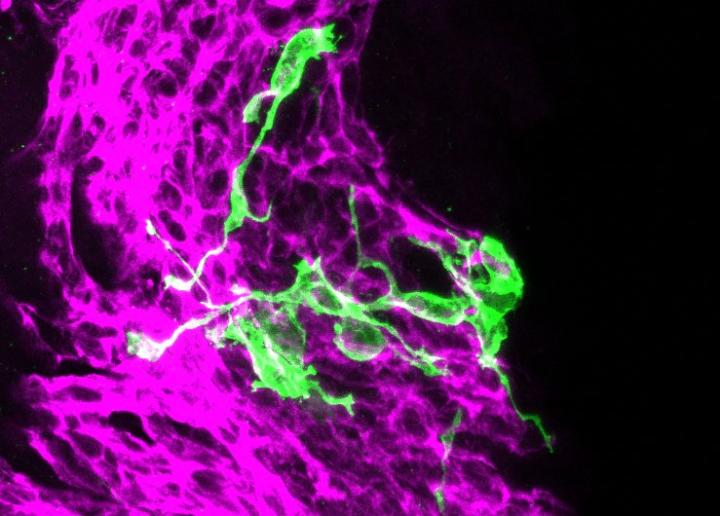
Credit: © Helmholtz Zentrum München
In mammals, generation of new neurons (neurogenesis) is mainly limited to early childhood and occurs in adulthood only in a few regions of the forebrain. One such exception is olfactory neurons, which develop from stem cells via several intermediate stages. “The production of these neurons diminishes with advancing age. In our recent study we wanted to find out the cellular basis and what role stem cells play in the process,” says Dr. Carsten Marr, explaining the approach. He is a research group leader at the Institute of Computational Biology (ICB) of Helmholtz Zentrum München.
To shed light on this question, an interdisciplinary team of experts from the Helmholtz Zentrum München was formed that included the mathematicians Lisa Bast and Carsten Marr as well as stem cell researchers Dr. Filippo Calzolari (now Institute of Physiological Chemistry at the University Mainz) and Professor Jovica Ninkovic. “Our approach utilised what are known as confetti reporters to perform lineage tracing: In mouse brains, we induced individual stem cells and all their descendants – called clones ? to light up in a specific colour”, says Filippo Calzolari. In this way, the scientists could distinguish clones over time by the different colours that give the technique its name. “In the next step, we compared clones found in young and older mice to find out what contribution individual stem cells and intermediates make to the neurogenesis of mature olfactory cells”, Calzolari adds.
Connect the dots
However, systematic analysis of these images proved nearly impossible for humans, in that the available data were extremely heterogeneous, making a comparison of young and old brains difficult. Here the expertise of Carsten Marr and his team came into play. They are specialists in the quantification of single-cell dynamics, i.e. the study of which and how many cells of a large population make which cell fate decisions. To do so, the researchers use artificial intelligence methods, develop mathematical models and deduce algorithms to help analyse the image data.
“We compared the confetti measurements with several mathematical models of neurogenesis,” explains Lisa Bast. “We found that the ability of self-renewal declines in old age, especially in certain intermediate stages called transit amplifying progenitors.” In addition, the analysis showed that asymmetric cell division and quiescence of stem cells increased in older mice. “That means that fewer cells differentiate into olfactory cells in old age as they tend to remain in the stem cell pool and become less active. Therefore, the production comes to a halt”, says Jovica Ninkovic. The work is the first in which scientists have been able to quantitatively describe the behaviour of neural stem cells in the living mammalian brain using a mathematical model.
###
Further Information
Background:
Carsten Marr is heading the ‘Quantitative Single Cell Dynamics’ group at the Institute of Computational Biology (ICB) of Helmholtz Zentrum München. Together with colleagues, he was awarded the Erwin Schrödinger Prize in 2017: The interdisciplinary research team had shown how data from individual blood cells can be used to calculate their further development. The mathematician Lisa Bast works on her PhD thesis in the group of Carsten Marr.
Jovica Ninkovic is a Professor at Ludwig Maximilian Universität München and heading the ‘Neurogenesis and Regeneration’ group at the Institute of Stem Cell Research (ISF) of Helmholtz Zentrum München. In collaboration with ISF Director Professor Magdalena Götz and Filippo Calzolari he has recently shown that both the rate of self-renewal and the diversity of stem cell neurons are limited and that the number of stem cells decreases with advancing age. The current work now identifies the specific steps on which these developments are based.
Original Publication:
Bast, L. & Calzolari, F. (2018): Increasing neural stem cell division asymmetry and quiescence are predicted to contribute to the age-related decline in neurogenesis. Cell Reports, DOI: 10.1016/j.celrep.2018.11.088
The Helmholtz Zentrum München, the German Research Center for Environmental Health, pursues the goal of developing personalized medical approaches for the prevention and therapy of major common diseases such as diabetes, allergies and lung diseases. To achieve this, it investigates the interaction of genetics, environmental factors and lifestyle. The Helmholtz Zentrum München is headquartered in Neuherberg in the north of Munich and has about 2,300 staff members. It is a member of the Helmholtz Association, a community of 18 scientific-technical and medical-biological research centers with a total of about 37,000 staff members. http://www.
The Institute of Computational Biology (ICB) develops and applies methods for the model-based description of biological systems, using a data-driven approach by integrating information on multiple scales ranging from single-cell time series to large-scale omics. Given the fast technological advances in molecular biology, the aim is to provide and collaboratively apply innovative tools with experimental groups in order to jointly advance the understanding and treatment of common human diseases. http://www.
The University Medical Center of Johannes Gutenberg University Mainz is the only medical facility providing supramaximal care in Rhineland-Palatinate while also functioning as an internationally recognized hub of medical science. It has more than 60 clinics, institutes, and departments that collaborate across the various disciplines. Highly specialized patient care, research, and teaching form an integral whole at the Mainz University Medical Center. Approximately 3,300 students are trained in medicine and dentistry in Mainz. With its approximately 7,500 personnel, the Mainz University Medical Center is also one of the largest employers in the region and an important driver of growth and innovation. Further information is available online at http://www.
Contact for the media:
Department of Communication, Helmholtz Zentrum München – German Research Center for Environmental Health, Ingolstädter Landstr. 1, 85764 Neuherberg – Tel. +49 89 3187 2238 – E-mail: [email protected]
Scientific Contact:
Dr. Carsten Marr, Helmholtz Zentrum München – German Research Center for Environmental Health, Institute of Computational Biology, Ingolstädter Landstr. 1, 85764 Neuherberg – Tel. +49 89 3187 2158, E-mail: [email protected]
Media Contact
Dr. Carsten Marr
[email protected]
49-893-187-2158
Original Source
https:/
Related Journal Article
http://dx.




